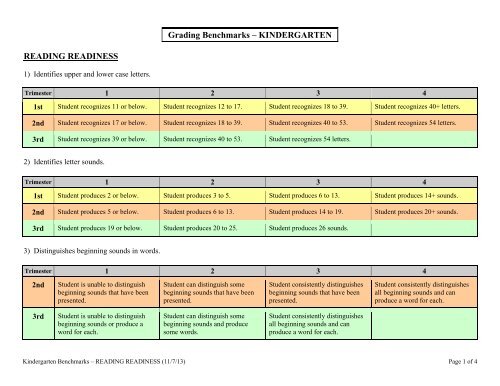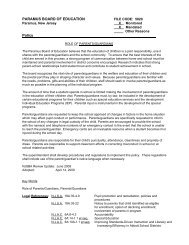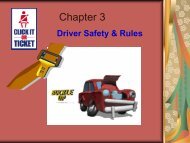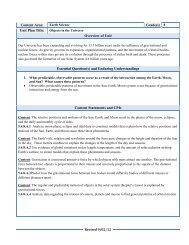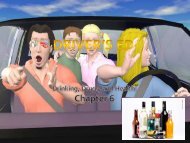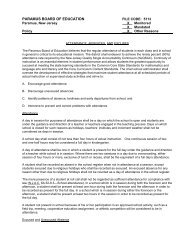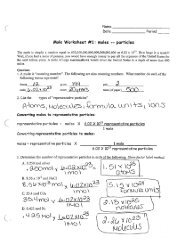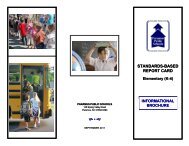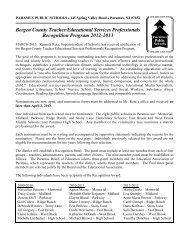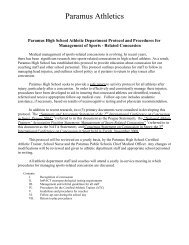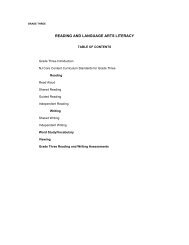Grading Benchmarks â KINDERGARTEN READING
Grading Benchmarks â KINDERGARTEN READING
Grading Benchmarks â KINDERGARTEN READING
Create successful ePaper yourself
Turn your PDF publications into a flip-book with our unique Google optimized e-Paper software.
<strong>Grading</strong> <strong>Benchmarks</strong> – <strong>KINDERGARTEN</strong><strong>READING</strong> READINESS1) Identifies upper and lower case letters.Trimester 1 2 3 41st Student recognizes 11 or below. Student recognizes 12 to 17. Student recognizes 18 to 39. Student recognizes 40+ letters.2nd Student recognizes 17 or below. Student recognizes 18 to 39. Student recognizes 40 to 53. Student recognizes 54 letters.3rd Student recognizes 39 or below. Student recognizes 40 to 53. Student recognizes 54 letters.2) Identifies letter sounds.Trimester 1 2 3 41st Student produces 2 or below. Student produces 3 to 5. Student produces 6 to 13. Student produces 14+ sounds.2nd Student produces 5 or below. Student produces 6 to 13. Student produces 14 to 19. Student produces 20+ sounds.3rd Student produces 19 or below. Student produces 20 to 25. Student produces 26 sounds.3) Distinguishes beginning sounds in words.Trimester 1 2 3 42ndStudent is unable to distinguishbeginning sounds that have beenpresented.Student can distinguish somebeginning sounds that have beenpresented.Student consistently distinguishesbeginning sounds that have beenpresented.Student consistently distinguishesall beginning sounds and canproduce a word for each.3rdStudent is unable to distinguishbeginning sounds or produce aword for each.Student can distinguish somebeginning sounds and producesome words.Student consistently distinguishesall beginning sounds and canproduce a word for each.Kindergarten <strong>Benchmarks</strong> – <strong>READING</strong> READINESS (11/7/13) Page 1 of 4
<strong>Grading</strong> <strong>Benchmarks</strong> – <strong>KINDERGARTEN</strong>4) Distinguishes ending sounds in words.Trimester 1 2 3 42ndStudent is unable to distinguish endingsounds that have been presented.Student can distinguish some endingsounds that have been presented.Student consistently distinguishesending sounds that have been presented.Student consistently distinguishesall ending sounds.3rdStudent is unable to distinguishending sounds in words.Student can distinguish someending sounds.Student consistently distinguishesall ending sounds.5) Recognizes and produces rhyming words.Trimester 1 2 3 42ndStudent is unable to recognize andproduce rhyming words.Student can recognize and producerhyming words some of the time.Student can recognize and producerhyming words consistently.3rdStudent is unable to recognize andproduce rhyming words.Student can recognize and producerhyming words some of the time.Student can recognize and producerhyming words consistently.6) Recognizes grade-level sight words.Trimester 1 2 3 42ndStudent recognizes 4 or fewer sightwords on Word IdentificationAssessment.Student recognizes 5 to 9 sightwords on Word IdentificationAssessment.Student recognizes at least 10 to 24sight words on Word IdentificationAssessment.Student recognizes 25 or moresight words on Word IdentificationAssessment.3rdStudent recognizes 19 or fewersight words on Word IdentificationAssessment.Student recognizes 20-24 sightwords on Word IdentificationAssessment.Student recognizes 25 to 34 sightwords on Word IdentificationAssessment.Student recognizes 35 or moresight words on Word IdentificationAssessment.Word recognition as indicated on the Teacher’s College Word List <strong>Benchmarks</strong> for Primary Assessments.Kindergarten <strong>Benchmarks</strong> – <strong>READING</strong> READINESS (11/7/13) Page 2 of 4
<strong>Grading</strong> <strong>Benchmarks</strong> – <strong>KINDERGARTEN</strong>7) Independent reading level.Trimester 1 2 3 42ndStudent is unable or rarely able todemonstrate reading behaviors.Student has achieved readingsuccess at Level A or B.Student has achieved readingsuccess at Level C.Student has achieved readingsuccess at Level D, E, or above.3rdStudent has achieved readingsuccess at Level B.Student has achieved readingsuccess at Level C.Student has achieved readingsuccess at Level D or E.Student has achieved readingsuccess at Level F or above.Reading level as indicated on the Teacher’s College Reading Level <strong>Benchmarks</strong> for the Independent Reading Level Assessment (IRLA).8) Demonstrates comprehension of a story read aloud.Trimester 1 2 3 42 nd Student is unable to retell a story,even with prompting.Student is unable to recall eventsof a story in proper sequence.Student is able to retell a story inproper sequence, using charactersand setting.Student is able to retell a story inproper sequence, using charactersetting and inferentialunderstanding.3 rd Student is unable to recall eventsof a story in proper sequence.Student is able to retell a story inproper sequence, using charactersand setting.Student is able to retell a story inproper sequence, using charactersetting and inferentialunderstanding.Student is able to retell a story insequence, using characters andsetting, while making connectionsand predictions (displaying higherlevel thinking).Kindergarten <strong>Benchmarks</strong> – <strong>READING</strong> READINESS (11/7/13) Page 3 of 4
<strong>Grading</strong> <strong>Benchmarks</strong> – <strong>KINDERGARTEN</strong>9) Uses print strategies to read unknown words.Trimester 1 2 3 42ndStudent is unable to use any printstrategies to read unknown words.Student uses some print strategiesfrequently to read unknown words.Student uses most print strategiesconsistently to read unknown words.Student employs all print strategiesconsistently to read unknown words.3rdStudent is unable to use any printstrategies to read unknown words.Student uses some print strategiesfrequently to read unknown words.Student uses most print strategiesconsistently to read unknown words.Student employs all print strategiesconsistently to read unknown words.10) Demonstrates an understanding of the concepts of print.Trimester 1 2 3 41st Student receives fewer than 4points on Concepts of PrintAssessment.Student receives 5 to 9 points onConcepts of Print Assessment.Student receives 10 points onConcepts of Print Assessment.Student receives 11 or more pointson Concepts of Print Assessment.2nd Student receives fewer than 9points on Concepts of PrintAssessment.Student receives 10 to 11 points onConcepts of Print Assessment.Student receives 12 points onConcepts of Print Assessment.Student receives 13 points onConcepts of Print Assessment.3rd Student receives fewer than 11points on Concepts of PrintAssessment.Student receives 12 points onConcepts of Print Assessment.Student receives 13 points onConcepts of Print Assessment.Kindergarten <strong>Benchmarks</strong> – <strong>READING</strong> READINESS (11/7/13) Page 4 of 4
<strong>Grading</strong> <strong>Benchmarks</strong> – <strong>KINDERGARTEN</strong>WRITING1) Uses pictures, letters, and strings of letters to express ideas.Trimester 1 2 3 41stStudent does not draw pictures ordictate to express ideas.Student draws pictures and dictatesto express ideas some of the time.Student draws pictures and dictatesto express ideas most of the time.Student consistently draws picturesand dictates to express ideas.2ndStudent draws pictures and dictatesto express ideas some of the time.Student draws pictures and dictatesto express ideas most of the time.Student draws pictures, dictates,and uses “writing” (beginning/ending sounds, labeling).Student consistently draws picturesand uses “writing” (decodablewords, high-frequency words, withspacing).3rdStudent draws pictures and dictatesto express ideas most of the time.Student draws pictures, dictates,and uses “writing” (beginning/ending sounds, labeling).Student draws pictures, dictates,and uses “writing” (decodablewords, high-frequency words, toexpress ideas in a sentence) mostof the time.Student consistently draws picturesand “writes,” using more than onesentence to elaborate on ideas.2) Applies conventions of grammar and usage.Trimester 1 2 3 42ndStudent does not demonstrateunderstanding of key concepts ofgrammar, usage, and mechanics.Student is beginning todemonstrate understanding of keyconcepts of grammar, usage, andmechanics, including: Capitalizing the first letter ofhis/her name. Capitalizing the pronoun “I.”Student demonstratesunderstanding of key concepts ofgrammar, usage, and mechanics,including: Capitalizing the first letter ofhis/her name. Capitalizing the pronoun “I.”Student consistently demonstratesunderstanding of key concepts ofgrammar, usage, and mechanics,including: Capitalizing the first letter ofhis/her name. Capitalizing the pronoun “I.”Kindergarten <strong>Benchmarks</strong> – WRITING (11/7/13) Page 1 of 4
<strong>Grading</strong> <strong>Benchmarks</strong> – <strong>KINDERGARTEN</strong>3rdStudent does not demonstrateunderstanding of key concepts ofgrammar, usage, and mechanics.Student is beginning todemonstrate understanding of keyconcepts of grammar, usage, andmechanics, including: Capitalizing the first letter ofhis/her name.Capitalizing the pronoun “I.”Capitalizing the first word in asentence.Student demonstratesunderstanding of key concepts ofgrammar, usage, and mechanics,including: Capitalizing the first letter ofhis/her name.Capitalizing the pronoun “I.”Capitalizing the first word in asentence.Student consistently demonstratesunderstanding of key concepts ofgrammar, usage, and mechanics,including: Capitalizing the first letter ofhis/her name.Capitalizing the pronoun “I.”Capitalizing the first word in asentence.3) Spells simple words phonetically using knowledge of sound-letter relationships.Trimester 1 2 3 42ndStudent cannot write a letter orletters for consonant and shortvowel sounds.Student can write a letter or lettersfor a few consonant and shortvowel sounds.Student can write a letter or lettersfor most consonant and shortvowel sounds.Student can write a letter orletters for all consonant andshort vowel sounds.Student spells simple wordsphonetically using knowledgeof sound-letter relationships.3rdStudent can write a letter or lettersfor a few consonant and shortvowel sounds.Student can write a letter or lettersfor most consonant and shortvowel sounds.Student can write a letter orletters for all consonant andshort vowel sounds.Student spells simple wordsphonetically using knowledgeof sound-letter relationships.Student spells simple words andhigh-frequency words.Kindergarten <strong>Benchmarks</strong> – WRITING (11/7/13) Page 2 of 4
<strong>Grading</strong> <strong>Benchmarks</strong> – <strong>KINDERGARTEN</strong>4) Sequences ideas into a story.Trimester 1 2 3 42nd Student’s ideas are unrelated. Organization is not yet evident. Significant parts or details arenot included in oral retell orsketching. Student does not yet dictate alabel for pictures or sketches.Student demonstrates someorganization and order whentelling or sketching a story.Student adds a relevant detail.Student dictates a label that ispartially related to the picture.Student demonstratesorganization when telling andsketching a story and includesparts relevant to the story.Student dictates or uses a labelwhen sketching.Student includes three relevantdetails.Student uses relevant labelswhen sketching.Student’s telling, sketching, andwriting are organized with abeginning, middle, and end andinclude four or more relevantdetails.3rd Student’s ideas are unrelated. Organization is not yet evident. Significant parts or details arenot included in oral retell orsketching. Student does not yet dictate alabel for pictures or sketches.Student demonstrates someorganization and order whentelling or sketching a story.Student adds a relevant detail.Student dictates a label that ispartially related to the picture.Student demonstratesorganization when telling andsketching a story and includesparts relevant to the story.Student dictates or uses a labelwhen sketching.Student includes three relevantdetails.Student uses relevant labelswhen sketching.Student’s telling, sketching, andwriting are organized with abeginning, middle, and end andinclude four or more relevantdetails.Kindergarten <strong>Benchmarks</strong> – WRITING (11/7/13) Page 3 of 4
<strong>Grading</strong> <strong>Benchmarks</strong> – <strong>KINDERGARTEN</strong>5) Forms letters correctly.Trimester 1 2 3 41stStudent copies a few letterscorrectly.Student copies most letterscorrectly.Student copies all letters that havebeen presented correctly.Student writes all upper and lowercase letters correctly.2ndStudent copies most letters thathave been presented correctly.Student copies all letters that havebeen presented correctly.Student writes most letters thathave been presented correctly.Student writes own name withcapitals and lowercase letters.3rdStudent writes some letterscorrectly.Student writes most letterscorrectly.Student writes all upper and lowercase letters correctly.Student writes all upper and lowercase letters correctly and applies inall areas of writing.Kindergarten <strong>Benchmarks</strong> – WRITING (11/7/13) Page 4 of 4
<strong>Grading</strong> <strong>Benchmarks</strong> – <strong>KINDERGARTEN</strong>LISTENING AND SPEAKING1) Listens to others and takes turns speaking.Trimester 1 2 3 4ALLStudent rarely listens to others andrarely takes turns speaking.Student occasionally listens toothers and occasionally takes turnsspeaking.Student consistently listens toothers and will take turn speaking.Student consistently listens toothers, restates information, andcomments in complete sentenceswith correct verb tense.2) Makes relevant contributions to classroom and group discussions.Trimester 1 2 3 4ALLStudent rarely participates inconversations with peers andadults about kindergarten topicsand text.Student occasionally participatesin conversations with peers andadults about kindergarten topicsand text.Student consistently participates inconversations with peers andadults about kindergarten topicsand text.Student has achieved grade-levelexpectations, restates keyelements, and asks questions forclarification.3) Asks questions to gain information.Trimester 1 2 3 4ALLStudent rarely asks questions togain information, seek help, orclarify something that is notunderstood.Student occasionally asksquestions to gain information, seekhelp, or clarify something that isnot understood.Student consistently asksquestions to gain information, seekhelp, or clarify something that isnot understood.Student consistently confirmsunderstanding of information byasking and answering questionsabout key details.Kindergarten <strong>Benchmarks</strong> – LISTENING AND SPEAKING (11/8/13) Page 1 of 1
<strong>Grading</strong> <strong>Benchmarks</strong> – <strong>KINDERGARTEN</strong>MATHEMATICS1) Understands and applies mathematical concepts.Trimester 1 2 3 41stSort and Classify: Student isunable or rarely able to sort andclassify by attributes andcombination of attributes.Sort and Classify: Student cansometimes sort and classify byattributes and combination ofattributes.Sort and Classify: Student can sortand classify by attributes andcombination of attributes.Sort and Classify: Student can sort and classifyby attributes and combinationof attributes. Student applies conceptsindependently to other situations.Position and Location: Student isunable or rarely able to identify theposition of objects using describingwords.Position and Location: Studentcan sometimes identify theposition of objects usingdescribing words.Position and Location: Student canconsistently identify the position ofobjects using describing words.Position and Location: Student can consistentlyidentify the position of objectsusing describing words. Student applies conceptsindependently to other situations.Patterns: Student is unable orrarely able to recognize, construct,and extend patterns.Patterns: Student is able torecognize, construct, and extendpatterns some of the time.Patterns: Student is able torecognize, construct, and extendpatterns all of the time.Patterns: Student is able to recognize,construct, and extend patternsall of the time. Student can extend knowledgeto more complex patterns orother situations.0 – 5: Student is unable or rarelyable to identify sets withmore/fewer and demonstrate thatnumbers can be represented indifferent ways.0 – 5: Student can sometimesidentify sets with more/fewer anddemonstrate that numbers can berepresented in different ways.0 – 5: Student can consistentlyidentify sets with more/fewer anddemonstrate that numbers can berepresented in different ways.0 – 5: Student can consistentlyidentify sets with more/fewerand demonstrate that numberscan be represented in differentways. Student can apply conceptsindependently to other situations.Kindergarten <strong>Benchmarks</strong> – MATHEMATICS (11-5-13) Page 1 of 8
<strong>Grading</strong> <strong>Benchmarks</strong> – <strong>KINDERGARTEN</strong>2ndComparing Numbers: Student isunable or rarely able todemonstrate greater/fewer than by1 or 2 and in relation to 5 and 10.Comparing Numbers: Student cansometimes demonstrategreater/fewer than by 1 or 2 and inrelation to 5 and 10.Comparing Numbers: Student canconsistently demonstrategreater/fewer than by 1 or 2 and inrelation to 5 and 10.Comparing Numbers: Student can consistentlydemonstrate greater/fewer than bymore than 1 or 2 and in relation to5 and 10. Student applies concept to othersituations independently.Geometry: Student is unable or rarely ableto identify 1- and 2-dimensionalshapes and their properties. Student is unable or rarely ableto identify symmetrical shapes.Geometry: Student sometimes identifies1- and 2-dimensional shapesand their properties. Student sometimes identifiessymmetrical shapes.Geometry: Student consistently identifies1- and 2-dimensional shapesand their properties. Student identifies symmetricalshapes.Geometry: Student consistently identifies1- and 2-dimensional shapesand their properties. Student identifies symmetricalshapes. Student demonstratesunderstanding of length,height, width, and vertices.Fractions and Ordinals: Student is unable or rarely ableto recognize equal parts of awhole or divide objects intohalves. Student is unable or rarely ableto use ordinal numberscorrectly to indicate position.Fractions and Ordinals: Student will sometimesrecognize equal parts of awhole and divide objects intohalves. Student sometimes usesordinal numbers correctly toindicate position.Fractions and Ordinals: Student will consistentlyrecognize equal parts of awhole and divide objects intohalves. Student consistently usesordinal numbers correctly toindicate position.Fractions and Ordinals: Student will consistentlyrecognize equal parts of awhole and divide objects intohalves. Student will recognize otherfractional parts of a whole(thirds, quarters, etc.).Measurement: Student is unable orrarely able to recognize andcompare objects by length,capacity, and height.Measurement: Student cansometimes recognize and compareobjects by length, capacity, andheight.Measurement: Student canconsistently recognize andcompare objects by length,capacity, and height.Measurement: Student can consistentlyrecognize and compare objectsby length, capacity, andheight. Student applies concepts toother situations independently.Kindergarten <strong>Benchmarks</strong> – MATHEMATICS (11-5-13) Page 2 of 8
<strong>Grading</strong> <strong>Benchmarks</strong> – <strong>KINDERGARTEN</strong>3rdLarger Numbers: Student is unable or rarely ableto identify patterns of odd/evennumbers and patterns on anumber chart to 100. Student is unable or rarely ableto count, read, and writenumbers to 20. Student is unable to composeand decompose numbers.Larger Numbers: Student can sometimesidentify patterns of odd/evennumbers and patterns on anumber chart to 100. Student can sometimes count,read, and write numbers to 20. Student can sometimescompose and decomposenumbers.Larger Numbers: Student can consistentlyidentify patterns of odd/evennumbers and patterns on anumber chart to 100. Student can count, read, andwrite numbers to 20. Student can consistentlycompose and decomposenumbers.Larger Numbers: Student can consistentlyidentify patterns of odd/evennumbers and patterns on anumber chart to 100. Student can count, read, andwrite numbers beyond 20. Student can make matchingsets of objects. Student can consistently composeand decompose greater than 40.Money: Student is unable or rarelyable to identify coins (penny,nickel, and dime) and understandstheir value.Money: Student sometimesidentifies coins (penny, nickel, anddime) and understands their value.Money: Student consistentlyidentifies coins (penny, nickel, anddime) and understands their value.Money: Student consistently identifiescoins (penny, nickel, dime,quarter, and half-dollar) andunderstands their value. Student can combine coins ina variety of patterns for anequal sum.Time: Student is unable or rarely ableto sequence events. Student is unable or rarely ableto identify time to the hour.Time: Student can sometimessequence events. Student can sometimesidentify time to the hour.Time: Student can consistentlysequence events. Student can identify time to thehour.Time: Student can consistentlysequence more than three events. Student can identify time tothe hour and half-hour.Graphing: Student is unable orrarely able to read and interpretdata on different types of graphs.Graphing: Student can sometimesread and interpret data on differenttypes of graphs.Graphing: Student canconsistently read and interpret dataon different types of graphs.Graphing: Student can consistently readand interpret data on differenttypes of graphs. Student can independentlycreate graphs to represent data.Calendar: Student is unable orrarely able to identify the monthsand seasons, the seven days of theweek, and dates on the calendar.Calendar: Student sometimesidentifies the months and seasons,the seven days of the week, anddates on the calendar.Calendar: Student consistentlyidentifies the months and seasons,the seven days of the week, anddates on the calendar.Kindergarten <strong>Benchmarks</strong> – MATHEMATICS (11-5-13) Page 3 of 8
<strong>Grading</strong> <strong>Benchmarks</strong> – <strong>KINDERGARTEN</strong>2) Demonstrates understanding of whole number concepts (counting, writing).Trimester 1 2 3 41st Student is unable or rarely ableto count sets from 0 to 5. Student is unable or rarely ableto identify and write numeralsfrom 0 to 5.Student can sometimes countsets from 0 to 5.Student can sometimesidentify and write numeralsfrom 0 to 5.Student can consistently countsets from 0 to 5.Student can consistentlyidentify and write numeralsfrom 0 to 5.Student can consistently countsets through 10.Student can consistentlyidentify and write numeralsfrom 0 to 10.2nd Student is unable or rarely ableto count sets through 10. Student is unable or rarely ableto identify and write numeralsfrom 0 to 10.Student can sometimes countsets through 10.Student can sometimesidentify and write numeralsfrom 0 to 10.Student can consistently countsets through 10.Student can consistentlyidentify and write numeralsfrom 0 to 10.Student can consistently identifyand produce numerals to 100.3rdStudent is unable or rarely able toidentify and produce numerals to 100.Student can sometimes identifyand produce numerals to 100.Student can consistently identifyand produce numerals to 100.Student can consistently identifyand produce numerals beyond 100.3) Uses a variety of strategies to solve problems.Trimester 1 2 3 41stSort and Classify: Student isunable to use strategies to solveproblems.Sort and Classify: Student islimited in the number of strategieshe/she can use to solve problems.Sort and Classify: Student uses avariety of manipulatives, paper andpencil, and appropriate mathlanguage to solve problems.Sort and Classify: Student uses a variety ofmanipulatives, paper andpencil, and appropriate mathlanguage to solve problems. Student uses logical reasoningabout the conditions of theproblem.Kindergarten <strong>Benchmarks</strong> – MATHEMATICS (11-5-13) Page 4 of 8
<strong>Grading</strong> <strong>Benchmarks</strong> – <strong>KINDERGARTEN</strong>Position and Location: Student is unable or rarely ableto position objects todemonstrate the relationship tosurrounding objects. Student is unable or rarely ableto describe in words.Position and Location: Student sometimes positionsobjects to demonstrate therelationship to surroundingobjects. Student can sometimesdescribe in words.Position and Location: Student consistently positionsobjects to demonstrate therelationship to surroundingobjects. Student can describe in words.Position and Location: Studentconsistently determines therelationship of objects andmaneuvers objects to replicate orcreate new positions relative toother objects.Patterns: Student is unable orrarely able to create patterns usingconcrete objects and drawingpictures.Patterns: Student is sometimesable to create patterns usingconcrete objects and drawingpictures.Patterns: Student is consistentlyable to create patterns usingconcrete objects and drawingpictures.Patterns: Student is consistently able tocreate complex patterns withobjects and drawings. Student is able to compare andcontrast the created complexpatterns.0 – 5: Student is unable or rarelyable to use manipulatives ormaking an organized list to solveproblems.0 – 5: Student sometimes usesmanipulatives and making anorganized list to solve problems.0 – 5: Student consistently usesmanipulatives and making anorganized list to solve problems.0 – 5: Student consistently usesmanipulatives and making anorganized list to solve problems. Student applies contentknowledge to other situationsindependently.2ndComparing Numbers: Student is unable or rarely ableto use counters to act out theproblem. Student is unable or rarely ableto use a variety ofmanipulatives to make sets.Comparing Numbers: Student sometimes usescounters to act out theproblem. Student sometimes uses avariety of manipulatives tomake sets.Comparing Numbers: Student uses counters to actout the problem. Student uses a variety ofmanipulatives to make sets.Comparing Numbers: Student uses counters to actout the problem. Student uses a variety ofmanipulatives to make sets. Student independently solvesproblems with mental mathstrategies.Kindergarten <strong>Benchmarks</strong> – MATHEMATICS (11-5-13) Page 5 of 8
<strong>Grading</strong> <strong>Benchmarks</strong> – <strong>KINDERGARTEN</strong>Geometry: Student is unable orrarely able to use paper and penciltasks, drawing objects, and othermanipulatives to demonstratefigures and symmetry.Geometry: Student sometimesuses paper and pencil tasks,drawing objects, and othermanipulatives to demonstratefigures and symmetry.Geometry: Student uses paper andpencil tasks, drawing objects, andother manipulatives to demonstratefigures and symmetry.Geometry: Student uses paper andpencil tasks, drawing objects, andother manipulatives to demonstratefigures, symmetry, length, height,vertices, and other attributes.Fractions and Ordinals: Student isunable or rarely able to use paperand pencil, scissors, cubes, andother manipulatives to act out aproblem.Fractions and Ordinals: Studentsometimes uses paper and pencil,scissors, cubes, and othermanipulatives to act out a problem.Fractions and Ordinals: Studentuses paper and pencil, scissors,cubes, and other manipulatives toact out a problem.Fractions and Ordinals: Student isable to determine fractions andordinals without manipulatives.Measurement: Student uses cubes and othermanipulatives. Student reasons through for a“first” answer.Measurement: Student uses cubes and othermanipulatives. Student reasons through for a“first” answer.Measurement: Student uses cubes and othermanipulatives. Student reasons through for a“first” answer.Measurement: Student is able toconsistently reason, estimate, andpredict answers and check toarrive at the correct answer.3rdLarger Numbers: Student is unable or rarely ableto use a ten-frame, a 100’schart, and manipulatives todesign number patterns. Student is unable or rarely ableto use other objects to make sets.Larger Numbers: Student sometimes uses a tenframe,a 100’s chart, andmanipulatives to designnumber patterns. Student sometimes uses otherobjects to make sets.Larger Numbers: Student uses a ten-frame, a100’s chart, and manipulativesto design number patterns. Student uses other objects tomake sets.Larger Numbers: Student employsmental math accurately andconsistently.Money: Student is unable or rarelyable to use coins to count moneyamounts and to act out buyingitems.Money: Student is sometimes ableto use coins to count moneyamounts and to act out buyingitems.Money: Student is able to usecoins to count money amounts andto act out buying items.Money: Student is able to usecoins and dollar bills to countmoney amounts, to act out buyingitems, and to make change.Time: Student is unable or rarelyable to use reasoning about theconditions of the problem andlogical thinking to solve it.Time: Student is sometimes ableto use reasoning about theconditions of the problem andlogical thinking to solve it.Time: Student is able to usereasoning about the conditions ofthe problem and logical thinking tosolve it.Time: Student is able to usereasoning about the conditionsof the problem and logicalthinking to solve it.Kindergarten <strong>Benchmarks</strong> – MATHEMATICS (11-5-13) Page 6 of 8
<strong>Grading</strong> <strong>Benchmarks</strong> – <strong>KINDERGARTEN</strong>Student can independentlyapply the content knowledgeto other situations.Calendar: Student is unable orrarely able to use pictures,diagrams, thermometers, andcalendars to solve problems.Calendar: Student sometimes usespictures, diagrams, thermometers,and calendars to solve problems.Calendar: Student uses pictures,diagrams, thermometers, andcalendars to solve problems.Graphing: Student uses counters,pattern blocks, color blocks, cubes,picture graphs, and bar graphs toanalyze data and solve problems.Graphing: Student uses counters,pattern blocks, color blocks, cubes,picture graphs, and bar graphs toanalyze data and solve problems.Graphing: Student uses counters,pattern blocks, color blocks, cubes,picture graphs, and bar graphs toanalyze data and solve problems.Graphing: Student uses counters,pattern blocks, color blocks, cubes,picture graphs, and bar graphs toanalyze data, compare and contrastresults, and solve problemsindependently.4) Understands and solves addition stories.Trimester 1 2 3 42ndStudent is unable or rarely able tojoin numbers representing additionusing the plus sign up to 10.Student can sometimes joinnumbers representing additionusing the plus sign up to 10.Student can consistently joinnumbers representing additionusing the plus sign up to 10.Student consistently applies theconcept of addition independently.3rdStudent is unable or rarely able tojoin numbers representing additionusing the plus sign up to 10.Student can sometimes joinnumbers representing additionusing the plus sign up to 10.Student can consistently joinnumbers representing additionusing the plus sign up to 10.Student consistently applies theconcept of addition independently.Kindergarten <strong>Benchmarks</strong> – MATHEMATICS (11-5-13) Page 7 of 8
<strong>Grading</strong> <strong>Benchmarks</strong> – <strong>KINDERGARTEN</strong>5) Understands and solves subtraction stories.Trimester 1 2 3 42ndStudent is unable or rarely able toseparate objects from a group andrepresent subtraction using theminus sign within 10.Student can sometimes separateobjects from a group and representsubtraction using the minus signwithin 10.Student can consistently separateobjects from a group and representsubtraction using the minus signwithin 10.Student consistently applies theconcept of subtractionindependently.3rdStudent is unable or rarely able toseparate objects from a group andrepresent subtraction using theminus sign within 10.Student can sometimes separateobjects from a group and representsubtraction using the minus signwithin 10.Student can consistently separateobjects from a group and representsubtraction using the minus signwithin 10.Student consistently applies theconcept of subtractionindependently.6) Forms numerals correctly.Trimester 1 2 3 41stStudent is unable or rarely able tocopy numerals from 0 to 5.Student can sometimes copynumerals from 0 to 5.Student can consistently copynumerals from 0 to 5.Student can write numerals from 0to 5 independently.2ndStudent is unable or rarely able towrite numerals from 0 to 10.Student can sometimes writenumerals from 0 to 10.Student can consistently writenumerals from 0 to 10.Student can write numerals greaterthan 10.3rdStudent is unable or rarely able towrite numerals greater than 10.Student can sometimes writenumerals greater than 10.Student can consistently writenumerals greater than 10.Student can write numerals 0 to100 independently.Kindergarten <strong>Benchmarks</strong> – MATHEMATICS (11-5-13) Page 8 of 8
<strong>Grading</strong> <strong>Benchmarks</strong> – <strong>KINDERGARTEN</strong>SCIENCE1) Demonstrates understanding of concepts. EARTH SCIENCE: Observing Trees in Their EnvironmentTrimester 1 2 3 41stStudent rarely demonstratesunderstanding of key concepts oftrees in their environment,including: Seasons affect trees and showpredictable patterns. There are different kinds oftrees with different shapes andstructures. There are different kinds ofleaves. The sun warms the land, air,and water. Plants need the sunlight, water,and soil to grow. Plants and animals depend onother organisms and theirenvironment to meet theirbasic needs. Scientists observe, record, andinvestigate to learn about theirnatural world.Student is beginning to demonstrateunderstanding of key concepts oftrees in their environment,including: Seasons affect trees and showpredictable patterns. There are different kinds oftrees with different shapes andstructures. There are different kinds ofleaves. The sun warms the land, air,and water. Plants need the sunlight, water,and soil to grow.Plants and animals depend onother organisms and theirenvironment to meet theirbasic needs.Scientists observe, record, andinvestigate to learn about theirnatural world.Student demonstratesunderstanding of key concepts oftrees in their environment,including: Seasons affect trees and showpredictable patterns. There are different kinds oftrees with different shapes andstructures. There are different kinds ofleaves. The sun warms the land, air,and water. Plants need the sunlight,water, and soil to grow. Plants and animals depend onother organisms and theirenvironment to meet theirbasic needs. Scientists observe, record, andinvestigate to learn about theirnatural world.Student meets standards and is ableto extend key concepts to real-lifeexperiences.Kindergarten <strong>Benchmarks</strong> – SCIENCE (11/5/13) Page 1 of 2
<strong>Grading</strong> <strong>Benchmarks</strong> – <strong>KINDERGARTEN</strong> PHYSICAL SCIENCE: Materials of Our WorldTrimester 1 2 3 42ndStudent rarely demonstratesunderstanding of key concepts ofpaper, wood, and fabric, including: Where wood/paper/fabric comesfrom. Where in the world we see thingsmade from wood/paper/fabric. Ways in which we can changethe structure of wood/paper/fabric. Ways in which we can preserveEarth’s natural resources. Scientists observe, record, andinvestigate to learn about theirnatural world.Student is beginning to demonstrateunderstanding of key concepts ofpaper, wood, and fabric, including: Where wood/paper/fabric comesfrom. Where in the world we see thingsmade from wood/paper/fabric.Ways in which we can changethe structure of wood/paper/fabric.Ways in which we can preserveEarth’s natural resources.Scientists observe, record, andinvestigate to learn about theirnatural world.Student demonstratesunderstanding of key concepts ofpaper, wood, and fabric, including: Where wood/paper/fabriccomes from. Where in the world we see thingsmade from wood/paper/fabric. Ways in which we can changethe structure of wood/paper/fabric. Ways in which we can preserveEarth’s natural resources. Scientists observe, record, andinvestigate to learn about theirnatural world.Student meets standards and is ableto extend key concepts to real-lifeexperiences. LIFE SCIENCE: Observing Animals in Their EnvironmentTrimester 1 2 3 43rdStudent rarely demonstratesunderstanding of key concepts ofanimals in their environment,including: Different animals interact withtheir environment in differentways. Animals’ structures andbehaviors help them survive intheir environment. Scientists observe, record, andinvestigate to learn about theirnatural world.Student is beginning to demonstrateunderstanding of key concepts ofanimals in their environment,including: Different animals interact withtheir environment in differentways. Animals’ structures andbehaviors help them survive intheir environment. Scientists observe, record, andinvestigate to learn about theirnatural world.Student demonstratesunderstanding of key concepts ofanimals in their environment,including: Different animals interact withtheir environment in differentways. Animals’ structures andbehaviors help them survive intheir environment. Scientists observe, record, andinvestigate to learn about theirnatural world.Student meets standards and is ableto extend key concepts to real-lifeexperiences.[Kindergarten <strong>Benchmarks</strong> – SCIENCE (11/5/13) Page 2 of 2
<strong>Grading</strong> <strong>Benchmarks</strong> – <strong>KINDERGARTEN</strong>SOCIAL STUDIES1) Demonstrates understanding of concepts. UNIT 1: All About MeTrimester 1 2 3 41stStudent rarely demonstratesunderstanding of key concepts ofourselves, others, and thecommunities to which we belong,including: Each person is unique andspecial. People are similar and different.Respecting others.We belong to severalcommunities, including ourfamily, our classroom, and ourschool.We use tools to learn about ourworld, including a map and anatlas.Rules and laws help people tobe safe and get along.People have wants and needs.People have jobs that providegoods and services.Authority figures at home, atschool, and in ourneighborhood help to makedecisions.There are consequences for notfollowing rules and laws.Student is beginning to demonstrateunderstanding of key concepts ofourselves, others, and thecommunities to which we belong,including: Each person is unique andspecial. People are similar and different.Respecting others.We belong to severalcommunities, including ourfamily, our classroom, and ourschool.We use tools to learn about ourworld, including a map and anatlas.Rules and laws help people tobe safe and get along.People have wants and needs.People have jobs that providegoods and services.Authority figures at home, atschool, and in ourneighborhood help to makedecisions.There are consequences for notfollowing rules and laws.Student demonstratesunderstanding of key concepts ofourselves, others, and thecommunities to which we belong,including: Each person is unique andspecial. People are similar and different.Respecting others.We belong to severalcommunities, including ourfamily, our classroom, and ourschool.We use tools to learn aboutour world, including a mapand an atlas.Rules and laws help people tobe safe and get along.People have wants and needs.People have jobs that providegoods and services.Authority figures at home, atschool, and in ourneighborhood help to makedecisions.There are consequences fornot following rules and laws.Student meets standards and is ableto extend key concepts to real-lifeexperiences.Kindergarten <strong>Benchmarks</strong> – SOCIAL STUDIES (11/7/13) Page 1 of 2
<strong>Grading</strong> <strong>Benchmarks</strong> – <strong>KINDERGARTEN</strong> UNIT 2: My Place in the WorldTrimester 1 2 3 42ndStudent rarely demonstratesunderstanding of key concepts ofperspective, distance, and location,including: A map is a bird’s-eye view ofa particular place. Colors, symbols, and the mapkey help us to locate places ona map. A globe is a model of theearth. We use north, south, east, andwest to locate places on a mapor globe. We identify the characteristicsof urban, rural, and suburbancommunities. Climate affects what we wear,what we eat, and what ourhomes look like.Student is beginning to demonstrateunderstanding of key concepts ofperspective, distance, and location,including:A map is a bird’s-eye view ofa particular place.Colors, symbols, and the mapkey help us to locate places ona map.A globe is a model of theearth.We use north, south, east, andwest to locate places on a mapor globe.We identify the characteristicsof urban, rural, and suburbancommunities.Climate affects what we wear,what we eat, and what ourhomes look like.Student demonstratesunderstanding of key concepts ofperspective, distance, and location,including: A map is a bird’s-eye view ofa particular place. Colors, symbols, and the mapkey help us to locate places ona map. A globe is a model of theearth. We use north, south, east, andwest to locate places on a mapor globe. We identify the characteristicsof urban, rural, and suburbancommunities.Climate affects what we wear,what we eat, and what ourhomes look like.Student meets standards and is ableto extend key concepts to real-lifeexperiences.[Kindergarten <strong>Benchmarks</strong> – SOCIAL STUDIES (11/7/13) Page 2 of 2
<strong>Grading</strong> <strong>Benchmarks</strong> – <strong>KINDERGARTEN</strong>ART1) Demonstrates understanding of skills and concepts.Trimester 1 2 3 4ALLElements and Principles of Art:Student needs support in thefollowing areas: Student is unable to create 2-and 3-dimensional works of artusing the basic elements/principles of art such asprimary colors, secondarycolors, color mixing, and line.Elements and Principles of Art:Student is approaching standardsin the following areas: Student is developing the skillsneeded to create 2- and3-dimensional works of artusing the basic elements/principles of art such asprimary colors, secondarycolors, color mixing, and line.Elements and Principles of Art:Student meets standards in thefollowing areas: Student is able to create 2- and3-dimensional works of artusing the basic elements/principles of art such asprimary colors, secondarycolors, color mixing, and line.Elements and Principles of Art:Student exceeds standards in thefollowing areas: Student is able to create 2- and3-dimensional works of artusing the basic elements/principles of art such asprimary colors, secondarycolors, color mixing, and line.Art History/Art Appreciation:Student needs support in thefollowing areas: Student rarely identifies basiccharacteristics of artists’ styles. Student rarely applies visualart vocabulary correctly whiledescribing artwork such aslandscape, self-portrait,portrait, and still life.Art History/Art Appreciation:Student is approaching standardsin the following areas: Student is beginning toidentify basic characteristics ofartists’ styles. Student is beginning tounderstand and apply visual artvocabulary correctly whiledescribing artwork such aslandscape, self-portrait,portrait, and still life.Art History/Art Appreciation:Student meets standards in thefollowing areas: Student understands and canidentify basic characteristics ofartists’ styles.Student understands and isable to apply visual artvocabulary correctly whiledescribing artwork such aslandscape, self-portrait,portrait, and still life.Art History/Art Appreciation:Student exceeds standards in thefollowing areas: Student understands andconsistently identifies basiccharacteristics of artists’styles. Student consistently appliesvisual art vocabulary correctlywhile describing artwork suchas landscape, self-portrait,portrait, and still life.Creative Process:Student needs support in thefollowing areas: Student rarely applies the useof elements of art and basicmedia in his/her artwork.Creative Process:Student is approaching standardsin the following areas: Student is beginning to understandand apply the use of elements of artand basic media in his/her artwork.Creative Process:Student meets standards in thefollowing areas: Student understands and appliesthe use of elements of art andbasic media in his/her artwork.Creative Process: Student understands andconsistently applies the useof elements of art andbasic media in his/herartwork.Kindergarten <strong>Benchmarks</strong> – ART (10/25/11) Page 1 of 2
<strong>Grading</strong> <strong>Benchmarks</strong> – <strong>KINDERGARTEN</strong>Student rarely uses toolsappropriate to the productionof works of art in a variety ofart media.Student is learning how to usetools appropriate to theproduction of works of art in avariety of art media.Student uses tools appropriateto the production of works ofart in a variety of art media.Student consistently uses toolsappropriate to the productionof works of art in a variety ofart media.Kindergarten <strong>Benchmarks</strong> – ART (10/25/11) Page 2 of 2
<strong>Grading</strong> <strong>Benchmarks</strong> – <strong>KINDERGARTEN</strong>MUSIC1) Demonstrates understanding of skills and concepts.Trimester 1 2 3 4ALLPerformance:Student needs support in thefollowing areas: Student is unable to echo theteacher by singing patterns,calls, and chants. Student is unable to keep thesteady beat through movement,clapping, and performing onrhythm instruments. Student is unable to performon non-pitched percussion andbarred/mallet instruments.Performance:Student is approaching standardsin the following areas: Student is developing theability to sing music of avariety of styles and cultures,alone and with others. Student is developing the abilityto echo the teacher by singingpatterns, calls, and chants. Student is developing theability to keep the steady beatthrough movement, clapping,and performing on rhythminstruments.Student is beginning todevelop performance skills onnon-pitched percussion andbarred/mallet instruments.Performance:Student meets standards in thefollowing areas: Student is able to sing musicof a variety of styles andcultures, alone and with others. Student is able to echo theteacher by singing patterns,calls, and chants. Student is able to keep thesteady beat throughmovement, clapping, andperforming on rhythminstruments. Student is able to perform onnon-pitched percussion andbarred/mallet instruments.Performance:Student exceeds standards in thefollowing areas: Student is consistently able tosing music of a variety ofstyles and cultures, alone andwith others. Student is consistently able toecho the teacher by singingpatterns, calls, and chants. Student is consistently able tokeep the steady beat throughmovement, clapping, andperforming on rhythminstruments.Student is consistently able toperform on non-pitchedpercussion and barred/malletinstruments.Listen and Respond:Student needs support in thefollowing areas: Student is unable to matchpitch when singing with theclass, echoing the teacher, orsinging with recordings. Student is unable todifferentiate between musicthat is loud/soft, and fast/slow.Listen and Respond:Student is approaching standardsin the following areas: Student is beginning to matchpitch when singing with theclass, echoing the teacher, orsinging with recordings. Student is beginning todifferentiate between musicthat is loud/soft, and fast/slow.Listen and Respond:Student meets standards in thefollowing areas: Student is able to match pitchwhen singing with the class,echoing the teacher, or singingwith recordings. Student is able to differentiatebetween music that isloud/soft, and fast/slow.Listen and Respond:Student exceeds standards in thefollowing areas: Student is consistently able tomatch pitch when singing withthe class, echoing the teacher,or singing with recordings. Student is consistently able todifferentiate between musicthat is loud/soft, and fast/slow.Kindergarten <strong>Benchmarks</strong> – MUSIC (10/25/11) Page 1 of 2
<strong>Grading</strong> <strong>Benchmarks</strong> – <strong>KINDERGARTEN</strong>Student is unable to critiquelevel-appropriate musicalperformance.Student is beginning tocritique level-appropriatemusical performance.Student is able to critiquelevel-appropriate musicalperformance.Student is consistently able tocritique level-appropriatemusical performance.Create:Student needs support in thefollowing areas: Student is unable to addmusically appropriate rhythmicaccompaniments. Student is unable to createmovement and dramatizationto follow song narrative andstory. Student is unable to createrhythmic and melodic patternson instruments, demonstratingan understanding of loud/softand fast/slow.Create:Student is approaching standardsin the following areas: Student is beginning to addmusically appropriaterhythmic accompaniments.Student is beginning to createmovement and dramatizationto follow song narrative andstory.Student is beginning to createrhythmic and melodic patternson instruments, demonstratingan understanding of loud/softand fast/slow.Create:Student meets standards in thefollowing areas: Student is able to addmusically appropriaterhythmic accompaniments. Student is able to createmovement and dramatizationto follow song narrative andstory. Student is able to createrhythmic and melodic patternson instruments, demonstratingan understanding of loud/softand fast/slow.Create:Student exceeds standards in thefollowing areas: Student is consistently able toadd musically appropriaterhythmic accompaniments. Student is consistently able tocreate movement anddramatization to follow songnarrative and story. Student is consistently able tocreate rhythmic and melodicpatterns on instruments,demonstrating an understandingof loud/soft and fast/slow.Reading and Notating:Student needs support in thefollowing areas: Student is unable to notate thebeat with graphics or shapes. Student is unable to identifyquarter notes and rests. Student is unable to visuallyfollow rhythmic symbols fromleft to right.Reading and Notating:Student is approaching standardsin the following areas: Student is beginning to notatethe beat with graphics orshapes with some accuracy. Student is beginning toidentify quarter notes and restswith some accuracy. Student is beginning tovisually follow rhythmicsymbols from left to right withsome accuracy.Reading and Notating:Student meets standards in thefollowing areas: Student is able to notate thebeat with graphics or shapes. Student is able to identifyquarter notes and rests. Student is able to visuallyfollow rhythmic symbols fromleft to right.Reading and Notating:Student exceeds standards in thefollowing areas: Student is consistently able tonotate the beat with graphicsor shapes. Student is consistently able toidentify quarter notes andrests. Student is consistently able tovisually follow rhythmicsymbols from left to right.Kindergarten <strong>Benchmarks</strong> – MUSIC (10/25/11) Page 2 of 2


